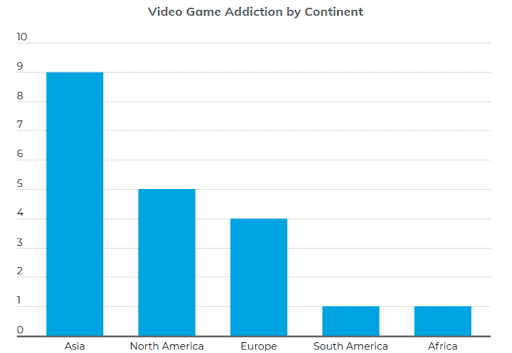
Molly Farrell
BSci majoring in Psychology, PGDp in Health Science
In developed countries, nearly 70% of people are playing video games, either on the computer, gaming consoles or their phones.
The average age of “gamers” is 35. It is predicted that in the next few years these numbers will exponentially rise and continue to increase. Playing video games has its benefits but the large majority are seemingly abusing it.
There are both positive and negative impacts of gaming. The question is, how do we differentiate between these and at what point do we classify gaming behaviours as a harmful addiction?
Video Game Addiction and Statistics (2020)
Video game culture first came into gear with the introduction of arcade gaming machines in the 70’s.[1]
This love for gaming rapidly grew, and now 50 years on, spending hours behind a screen is considered a norm, while the gaming industry has skyrocketed into a multi billion dollar corporation.[2]
This is all well and good, however, research continues to uncover the potential negative effects of compulsive gaming which should not be overlooked.
The graph below highlights Asia as the top continent for excessive video game use. The use of video games has been deemed so high that some governments have established regulations around gaming.
The government of Singapore, for example, has set up classification systems for video games. This system controls the promotion of certain games to certain age groups, with the goal of minimizing the harm of gaming.[2]

Gaming in New Zealand
In New Zealand, 67% of our population play video games, with an average of 88 minutes spent gaming per day.[3] This aligns with the accessibility we have as 97% of households in New Zealand have computer games. It is no secret that video gaming is a much loved trend among us.[3]

Interestingly, the investment with gaming does not stop at just playing the games themselves. There is a growing trend of watching walkthroughs or streamed play too. In New Zealand, 48% of our population have tuned in to do so.[3]
How can we explain this level of commitment?
Video games and our brain chemistry (why are video games so addictive)
As with anything addictive, our brain reward system is the key driver behind the desire to play video games. Video games challenge a certain skill set and as our brains are challenged, our dopamine reward system is activated and we feel pleasure.[1]
Our dopamine reward system should not be underestimated. It is this same reward system that is activated with food, sex and drugs and holds the power of creating addiction.
This desire for a dopamine release can quite easily flow into an addiction to gaming and there are key factors that can increase the likelihood of this happening.
Researchers studied a sample of 154 adolescent video gamers to investigate the implications video gaming can have on our brain. This sample was split into two groups, those who gamed at least 9 hours a week and those with less frequent gaming habits.[4]
Researchers noticed that those who played at least 9 hours a week had larger amounts of grey matter on the left side of their brain, inclusive of the ventral striatum.[4] This part of the brain plays a key role in our reward system and addiction.
The dopamine release that flows through this ventral striatum can be viewed as a “code of pleasure”. Some researchers hypothesize that the better the individual is at gaming the more reward they will receive which in turn impacts the growth of addiction.
Unfortunately, a significantly larger striatum can be problematic and is often related to other mental health conditions such as schizophrenia, obsessive compulsive disorder and anxiety.[4]
What makes someone vulnerable to this addiction?
Cam Adair, a leading expert on video game addictions, took the TedX stage to share his story on his own gaming problem.[4] In his Ted Talk, Adair reveals the lengths he would go to feed his addiction.
His dependency peaked during the time his father thought he was dropping his son off to a full time job. His father later learnt his son was in fact unemployed and bussing straight home each day to maintain his gaming habits.
You can watch Cam’s presentation where he talks about his struggles with gaming addiction.[4]
Adair identified the crux of his addiction – social incompetence which is also heavily supported by scientific research.[4] Studies have found that psychosocial mental disorders, low social competence and low self esteem are all antecedents of gaming disorder. Individuals rely on gaming as a social substitute.
As Adair reminisces, when “socializing” through a game, no judgements are passed on beyond your gaming abilities, which provides gamers with a sense of comfort and security.
RELATED — Are we “The Anxious Generation”
Gaming disorders mirror the development of many other addictions. These core issues stem from the same key risk factors during development, trauma, family disruption and parental approaches.[5]
These trends among the development of problematic video gaming have become evident in the unprecedented times around Covid-19.
RELATED — 10 Strategies for Mental Health while working from home
We have seen a dramatic increase of gaming worldwide, as many individuals have turned to video games to fill social voids.
However, the increase of gaming over these times does highlight a key driver of these habits, which is mental relief. It is through this use where gaming can become problematic.
Signs of video game addiction (playing video games is not a hobby)
Excessive gaming can result in significant neglect of other areas of someone’s life. When video gaming becomes a top priority, other daily routines and selfcare can easily be pushed to the side.
The prioritisation of gaming over other important responsibilities in life may call for intervention.
How do we define problematic gaming?
In 2013, Gaming Disorder was listed in the Diagnostic and Statistical Manual of Mental Disorders (DSM-5), an index of psychological disorders from the American Psychological Association.
Since then, Gaming Disorder has also been defined in the 11th Version of the International Classification of Disease by the World Health Organisation in 2018.
The World Health Organization classifies three key components of gaming disorder, which are the signs of video game addiction.
These signs of video game addiction are:
1. Impaired control over gaming
2. Increasing priority towards gaming over other activities to the detriment of social, personal and occupational areas of their life
3. Continued dedication despite harmful consequences occurring for at least 12 months.[2]
In the next section, we have highlighted physical signs of gaming addiction, that overtime seem to increase.
The negative impacts of gaming
In light of the three components of gaming disorder highlighted by WHO, the American Psychological Association also highlights a few warning signs indicative of problematic gaming:
- Increased irritability, anxiety or anger when having to stop gaming
- Experiencing symptoms of withdrawal in response to stopping gaming such as sleeplessness, loss of appetite or emotional outbursts
- Neglecting personal hygiene
- Poor performance at work or school
- Using gaming as a way to escape from other areas of their life.
As established by the World Health Organization, problematic gaming can be diagnosed when an individual’s gaming habits have severe consequences on these other elements of their life for at least 12 months.
By this point, video gaming is no longer a harmless hobby. Once this level of prioritisation is in action, the individual should seek support with controlling these compulsive behaviours.
Unfortunately these actions are followed with consequences and when gaming is taken too far, gaming addictions can have severe implications on our mental wellbeing.
A study measuring the impact of gaming found gamers who had played more than 5 hours a day were established as high risk and found to have lower self esteem, higher depression score and lower grade point average.[6]
22% of gamers play multiplayer games for 61%-80% of their day.
Dedication to video games can promote a negative feedback loop for individuals already challenged with these psychosocial factors increasing their vulnerability to form an addiction.
How to stop video game addiction
In some cases, individuals addicted to video games may need to go through a detox stage as they wean themselves off these habits.
Assisting them with alternatives to gaming can offer great support over this time. For those stuck in a cycle of compulsive gaming, certain treatment may be required.[7]
One type of therapy proven to support problematic gaming is Cognitive Behavioural Therapy. CBT is a type of therapy designed to help people challenge unhealthy habits and understand their ways of thinking. CBT programmes flow on to individuals setting their own goals and learning tools to achieve these.
As problematic gamers happily prioritize gaming over other aspects of their life, they can often miss seeing a problem at hand.
CBT can break down this barrier and provide a new lens of insight into what the implications of their habits may be.[7]
How to support healthy gaming habits
To quote Adair, “parents, it comes down to you”.[4] Being both teachers and carers, parents have the opportunity to prevent gaming addictions by investing in the development of social abilities. The first point of call is to put the device down.[5]
Children need strict limits on screen time and this must start from a young age. TV’s, Ipads and smartphones have become a main source of entertainment at the expense of personal, face to face activity.
As Adair says, “It isn’t about how we play the games, it is about why we play the games.”[4]
Parents have the responsibility to promote in-person interaction. Video game addiction is not limited to young adults and in New Zealand a high 85% of parents play video games too.[3] Parents too need to find their own balance of use to model to their children.
As noted, kids are falling into the gaming world due to a lack of confidence in social settings.[6]
To help your child through problematic gaming, you must help your child with their social skills, spend time teaching them how to make friends and help combat loneliness.
The positive components of gaming
With all this being said, video games are not all bad and studies have found some great benefits of healthy gaming.
Video games have shown to improve cognitive function and memory, as well as develop greater mental focus. Gamers have shown to have quicker reaction times and addition to this, gaming can also improve spatial awareness and vision.
Video gaming also holds significant social components which, particularly with situations where a lockdown has been invoked, can offer positive benefits.[8]
Keeping these points in mind, video gaming can have its place in our lives. Yet the negative components of gaming warrant monitorinsation of these habits, there are both risks and rewards.
As our dependency on technology continues to rise, our awareness around the risks of gaming addiction must too.
Mental Health and Wellness Advocate
With extensive experience as a mental health support worker, Molly knows first hand the impact our mind can have on our physical, emotional and social wellbeing. She has completed a Bachelor’s of Science, majoring in Psychology, and a postgraduate diploma in Health Science, which gives her an opportunity to combine theoretical knowledge with practice.
Molly’s goal and focus is to provide others with education and awareness on how we can improve our mental wellness and of those around us.
References
(1) Watkins, M. (2021). Video Game Addiction, Symptoms and Treatment. American Addiction Centers.
(2) Shaalan, K. (2021). Video Game Addiction: Statistics and Addiction. Game Gavel. https://gamegavel.com/video-game-addiction-statistics/
(3) Brand, J. E. & Todhunter, S. (2015). Digital New Zealand 2016. Bond University. https://www.igea.net/wp-content/uploads/2015/09/Digital-New-Zealand-2016-DNZ16.pdf
(4) Adair, C. (2013). Escaping Video Game Addiction [Video]. Ted Conferences. https://www.youtube.com/watch?v=EHmC2D0_Hdg&ab_channel=TEDxTalks
(5) Saunders, J.B., Hao, W., Long, J., King, D.L., Mann, K., Fauth-Buhler, M., Rumpf, H.J., Bowden-Jones, H., Rahimi-Movaghar, A., Chung, T., Chan, E., Bahar, H., Achab, S., Kook Lee H., Potenza, M., Petry, N., Spritzer, D., Ambekar, A., Derevensky, J., Griffiths, M.D., Pontes, H.M., Kuss, D., Higuchi, S., Mihara, S., Assangangkornchai, S., Sharma, M., Kashef, A.E., Ip, P., Farrell, M., Scafato, E., Carragher, N & Poznyak, V. (2017). Gaming Disorder: Delineation as an important condition for diagnosis, management and prevention. Journal of Behavioural Addictions, 6 (3), 271-279. https://www.ncbi.nlm.nih.gov/pmc/articles/PMC5700714/
(6) Papay, O., Urban, R., Griffiths, M.D, Nagygyorgy, K., Farkas, J., Kokonyei, G., Felvinczi, K., Olah, A., Elekes Z & Demetrovics, Z. (2013). Psychometric Properties of the Problematic Online Gaming Questionnaire Short- Form and Prevalence of Problematic Online Gaming in a National Sample of Adolescents. Cyber Psychology, Behaviour and Social Networking, 16 (5), 340-348. https://www.ncbi.nlm.nih.gov/pmc/articles/PMC3678653/
(7) Gordon, S. (2019). Addicted to video games? This treatment might help. Medical Press.
(8) Szalavitz, M. (2011). Brain Changes in Video Gamers: Addiction or Just People Having Fun? TIME. https://healthland.time.com/2011/11/18/brain-changes-in-video-gamers-addiction-or-just-people-having-fun/






